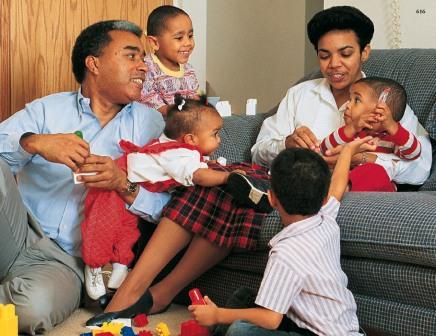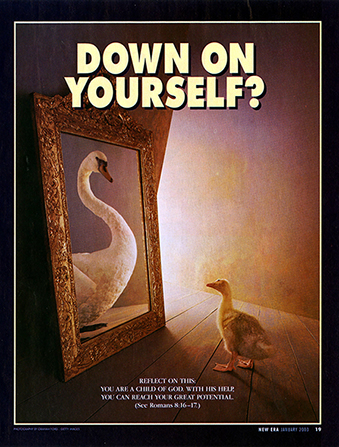The Church of Jesus Christ of Latter-day Saints, whose members are informally known as Mormons, has launched a new website designed to help strengthen families in these challenging times. It focuses on a program practiced by Mormons that can be easily adapted to families of any faith. This program, Family Home Evening or Family Night, brings the family together one night a week to learn and play as a family. It is generally a time just for families—no friends or guests are normally included.
Mormons usually hold this family night on Monday evenings, a time that is traditionally pretty calm. Of course, if Mondays are impossible, another night can be chosen, but Mormons hold no church meetings or activities that night, making it the easiest time for most families. It is set aside as a time dedicated to family life.
The first page offers a list of the basics: start and end with prayer, learn from the scriptures, include music, hold the meeting consistently, add variety, and make it fun. There are examples from Mormons who share their most memorable family home evenings and talks from leaders about why it matters. The remainder of the site includes sample lesson plans, ideas for future lessons, religious pictures that can be used in the lessons, teaching help, and activity ideas.
If you’d like to try a family night at home, tailored to your own beliefs and needs, it is very easy to adapt the Mormon program. A number of other religions have begun to adopt this idea from the Mormons.
It’s important for each member of the family to have a role to play in the evening’s plans. This gives each person a stake in how it turns out and makes them feel like an important part of the process. In addition, it teaches them important life and leadership skills. Very young children can be partnered with an older family member to help them carry out their part in the evening. Each job should be rotated so everyone has a chance to learn each skill. Even a toddler can give a prayer with help and a preschooler can teach a lesson with Daddy’s help and lots of pictures. A simple chart with movable names can make it easy to rotate assignments.
Often, the meeting begins with a nice family dinner. A good meal with favorite foods and great conversation strengthens the family and gets them in a good mood for some extended family time. When dinner ends, everyone can help with cleanup and then move together to the room you’ll be using for your family night.
Begin your family night with a prayer in order to invite God to be a participant in it and to give it the best possible chance for success.
You might also like to include an opening song before or just after the prayer. A hymn can help invite a reverent feeling and prepare people for the prayer. If your family doesn’t know any hymns, you can take a little time each week to teach one. In time your family will have a wide range of hymns to choose from. You don’t have to be great singers to enjoy singing together. One assignment on your rotation chart should be for someone to conduct the music. That person can just wave his arms around (and choose the hymn) but family night can also be a time to encourage children to learn to conduct music properly. The Mormons offer a basic free online course in conducting music. You do not have to register for the class. Simply go to the website and work through the materials at your own pace. On this same site, you’ll also learn how to accompany others, if you have a piano, how to teach a new song to children, and how to understand music symbols. Learning about music or learning new songs can be a part of your family home evening.
Next, families have a brief lesson on a spiritual or practical topic. For example, you might learn about prayer, treating each other with kindness, or emergency preparedness. The lesson should include a variety of pictures, songs, and activities to keep the attention of the students. It does not need to be a long lesson.
The website has a variety of lessons. While the website is aimed at Mormons and for this reason the lessons tend to be Mormon in nature, they are easily adaptable. Let’s look at one lesson to see how to take out the Mormonism and turn it into a lesson you are comfortable giving:
Lesson 12 is called Jesus is My Example. If you are Christian, this is a topic you will be comfortable teaching. As you read through the lesson, you’ll note all the scripture references are from the King James translation of the Bible, so most likely you will also be comfortable using those scriptures, although you may decide to use your own preferred translation. Mormons always use the King James translation when reading the Bible in English.
The For the Parent section is designed to help the teacher—whether a parent or a child—understand the primary purpose of the lesson. The preparation section helps you remember what needs to be done in advance. In this case, the teacher needs to obtain a blindfold and make a simple chart. The chart does not need to be fancy.
Next, the lesson offers two suggestions for songs. These are Mormon songs, but you may find they fit your doctrinal needs. If not, replace them with other songs. Everything in the lesson is just a suggestion. The links for these songs go only to the text, so you can see if the words are appropriate to your beliefs. If you want to learn the songs or choose different songs, you can go to the interactive hymn book, which gives you the music and even lets you hear people singing the hymns. You may want to look through the hymns about Jesus for this lesson. Some are hymns borrowed from Protestant churches and will be familiar to you. There is a similar list of children’s hymns about Jesus. One children’s hymn most Protestants would feel comfortable singing is, “I’m Trying to Be Like Jesus.”
The next part of the page is the actual lesson material. The bold headlines tell you which aspect of the topic is being covered so you can stay on topic. The information in parentheses are usually possible answers your family might give.
Notice the lesson begins with an activity designed to draw your family into the lesson. This is often more effective than starting out with a lecture or a scripture. It captures their attention and lets them know the lesson will be both fun and spiritual. As you do this activity, give some thought to safety, since the lights will be out. If you have young children, they are likely to all want a turn. Remember, it’s your lesson, so adapt as you see fit.
Now that you have everyone’s attention and you’ve had a brief discussion to show them why that activity applies to the topic, you’re ready to get to the heart of the lesson. You’ll need to adapt this according to the age and experiences of your family. You begin by asking a question and giving the family time to answer it. You can guide them to new ideas by having them read some of the Bible verses listed and you can also ask follow-up questions that help them think about the question in more depth if they are older. (Why do you think Jesus made an extra effort for children? Can you think of any times in the Bible when He showed His love for children?) If they are young, include just one or two scriptures and use more pictures to make your point. You can find pictures of Jesus in the Gospel Art Kit. Print them out or show them on your computer.
Children learn from stories of other children who are like them. This lesson includes a story about a ten-year-old girl who has to decide between a good and a bad choice. Below the lesson materials are adaptations for older and younger children and each contains another story. You can alter these stories in any way that suits your needs. Only one contains a specific Mormon reference. In the adaptation for teens and adults, Roger is preparing his Gospel Doctrine lesson. This is the name of the Mormon adult Sunday School lesson. Simply change the story to say he was preparing his Sunday School lesson or use whatever term your church uses for an adult religion class. If you have only sons, change girls to boys. Change the age to match that of your child. Adapt the story to fit a circumstance that might fit your family, but don’t embarrass a child by using his own bad choices in the story or by drawing public attention to them. Family home evening should be a pleasant and anticipated event, not one filled with dread or taught with pointed and embarrassing lessons. While you do need to cover topics your family is facing, do so with love and gentleness.
If you have a family with both teens and young children, include material suitable for both. If an activity is too sophisticated for the younger children, such as the self-evaluation in this lesson, give younger children a picture to color or draw instead and when the activity ends, have them show what they drew.
End your family night with some games you all enjoy and a special treat. This lets the family end the evening with pleasant memories. Finish up with another song and a closing prayer before sending everyone off to bed or evening activities.
Holding family home evening every week will strengthen your family, help you draw closer to one another, allow you to share you personal values, and help create memories to last forever.
About Terrie Lynn Bittner
The late Terrie Lynn Bittner—beloved wife, mother, grandmother, and friend—was the author of two homeschooling books and numerous articles, including several that appeared in Latter-day Saint magazines. She became a member of the Church at the age of 17 and began sharing her faith online in 1992.







